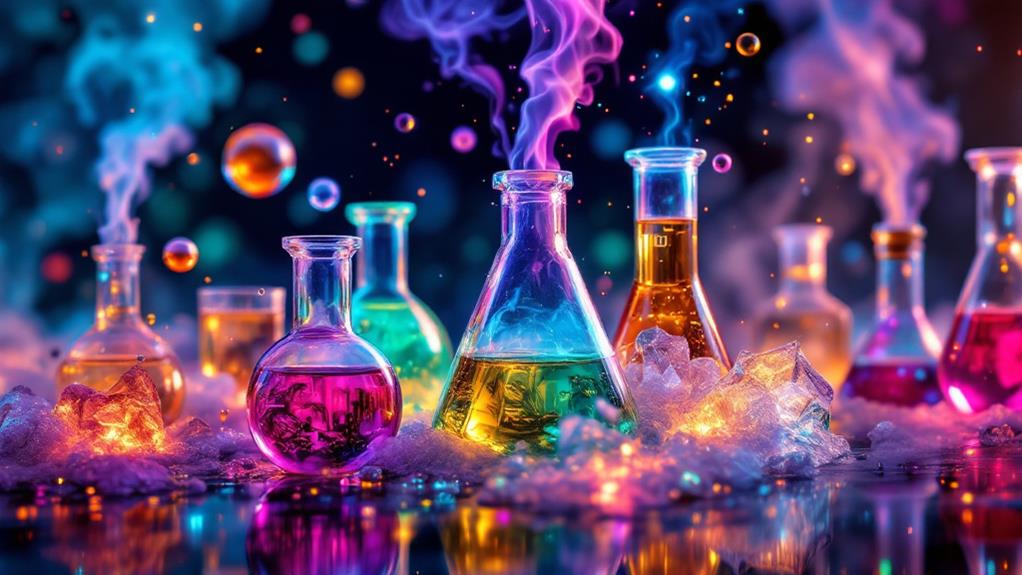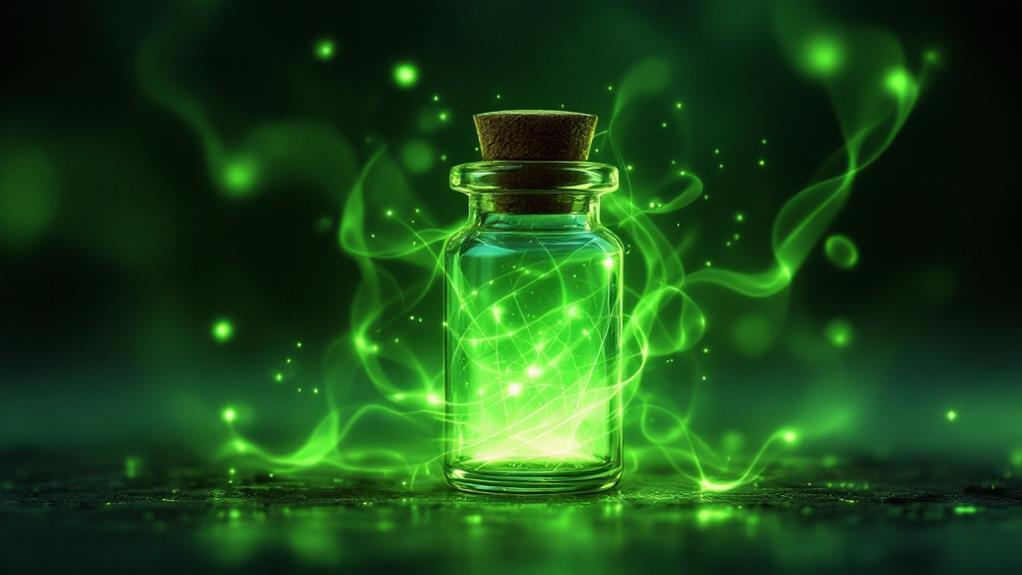The Coolest Elements on the Periodic Table: Fascinating Chemical Properties

Reveal the wonders of some of the coolest elements with their incredible properties. Imagine cesium, an alkali metal that reacts explosively with water, or phosphorus, which can glow in the dark. Noble gases like helium and neon surprise with their stability and unique uses, while iron shines as a magnetic powerhouse in industry. Radium captures attention with its historic luminescence and medical impact, and mercury intrigues with its liquid state at room temperature despite toxic dangers. There's a rich tapestry of science and intrigue waiting that will surely expand your horizons about these fascinating elements.
The Explosive Nature of Cesium
Cesium often captivates chemists with its highly reactive and explosive nature. When you look at cesium, you're dealing with an alkali metal that's keen to lose its single valence electron. This enthusiasm makes cesium reactivity one of the most intense among the elements. As you handle cesium, keep in mind that it has a much lower melting point than other metals, which means it can easily become liquid, increasing its surface area and reactivity.
Imagine dropping cesium into water. The reaction isn't just vigorous; it's explosive. The cesium rapidly reacts with water to form cesium hydroxide and hydrogen gas, sometimes resulting in a fiery explosion. This spectacle is a classic demonstration of cesium's explosive compounds, which release energy with remarkable force. You might wonder why cesium reacts so violently compared to its periodic table neighbors. It all boils down to its atomic structure and the energy required to remove that outermost electron.
When you investigate cesium's chemistry, you can't ignore its role in explosive compounds. The element's reactivity doesn't just make it a curiosity; it plays a critical part in developing materials that harness its explosive potential for practical applications.
Phosphorus: The Element That Glows
While cesium's explosive reactivity leaves a lasting impression, phosphorus captivates with its unique ability to glow. You might be intrigued to learn that phosphorus exists in several forms, known as allotropes. The most famous is white phosphorus, which glows in the dark due to a process called chemiluminescence. This luminescence occurs when phosphorus is exposed to oxygen, and it was this property that led to its revelation in the 17th century.
Phosphorus isn't just about glowing; it's critical in agriculture. As a key component of fertilizers, phosphorus plays an indispensable role in plant growth. Without it, plants struggle to photosynthesize effectively, impacting food production. The form used in agriculture is usually phosphate, derived from mineral sources. This use highlights phosphorus's significance beyond its glowing allure.
Exploring phosphorus further reveals other allotropes, like red and black phosphorus. Red phosphorus is more stable and safer to handle, making it useful in safety matches and fireworks. Black phosphorus, the least reactive, has potential in electronics due to its unique conductive properties. In both agriculture and technology, phosphorus continues to make its mark, proving that this glowing element is versatile and fundamental.
Noble Gases: Inert but Intriguing

Amidst the periodic table's lively array of elements, the noble gases stand out due to their intriguing inertness. These elements, including helium, neon, argon, krypton, xenon, and radon, are known for their lack of reactivity. You might wonder why these gases are so unreactive. It's because they have a full valence shell of electrons, making them stable and uninterested in forming bonds with other elements. Despite this, they have fascinating roles in numerous fields.
Noble gas applications are extensive and varied. Helium is crucial in cryogenics and as a lifting gas for balloons. Neon lights up our streets with its colorful glow, providing both beauty and practicality. Argon is used in welding and preserving historical documents due to its non-reactive nature. Krypton and xenon find their places in lighting and laser technology, showcasing rare gas uses that extend even to advanced medical imaging techniques. Radon, although radioactive, contributes to geological research and tracing groundwater paths.
Iron's Magnetic Marvel
Iron, one of Earth's most plentiful elements, captivates with its magnetic properties. You might not realize it, but magnetism is one of the defining characteristics of iron. This element's ability to become magnetized and attract other metals isn't just a scientific curiosity; it has a profound impact on technology and industry. From ancient times, iron's magnetic marvels have held historical significance, guiding adventurers across oceans with the help of simple compasses.
Iron's magnetic powers come into play when you think of iron alloys like steel. These alloys are crucial in constructing buildings, bridges, and vehicles because they combine strength with magnetic properties. The inclusion of other elements to iron can improve or reduce its magnetic abilities, offering flexibility in design and functionality.
You see iron's influence every day in the form of magnets, electric motors, and generators. The world as you know it would be drastically different without these magnetic marvels. Iron's ability to be magnetized and form strong, durable alloys makes it indispensable. Fundamentally, the magnetic marvel of iron is not only fascinating but foundational to modern civilization's infrastructure and technological advancements.
The Radiance of Radium

Few elements have captured the imagination quite like radium, with its luminescent glow that once seemed almost magical. You might be fascinated to learn how radium's revelation in 1898 by Marie and Pierre Curie changed the world. Its historical significance can't be overstated. Not only did radium's glow spark public curiosity, but it also paved the way for advancements in science and medicine.
In the early 20th century, radium applications were both groundbreaking and widespread. It was used in luminous paints for watch dials, instrument panels, and even in some household products. The belief in its health benefits led to radium being included in everything from cosmetics to tonics, although this was later debunked.
The real breakthrough, however, was its use in medical treatments. Radium's radioactive properties made it invaluable in early cancer therapy, offering hope where little existed before. While it's no longer used in modern treatments due to safety concerns, its role in pioneering radiation therapy remains a tribute to its impact.
Understanding radium's allure and its practical applications underscores its place in history, reminding you of the blend of wonder and caution that accompanies scientific revelation.
Mercury: Liquid Metal Wonders
When you think of mercury, the striking image of a shimmering, silvery liquid comes to mind, defying gravity as it beads and flows. It's unlike most elements, remaining liquid at room temperature, which makes it fascinating and practical. You probably know mercury from its vital role in thermometer applications. Its ability to expand and contract uniformly with temperature changes makes it perfect for measuring temperature. The precision and reliability of mercury thermometers have made them a staple in science and medicine, even though digital alternatives are more common today.
However, mercury's story isn't all positive. Its toxic properties pose significant health risks, especially when inhaled or absorbed through the skin. You must handle it with care since exposure can lead to severe neurological and physiological damage. The environmental impact is also a concern, as mercury can accumulate in ecosystems, harming wildlife and entering the food chain.
Despite these dangers, mercury's unique attributes have captivated scientists for centuries, driving innovation and caution. When you investigate its wonders, remember both the brilliance and the hazards, appreciating the delicate balance of nature's elements. Treat mercury with respect, understanding its benefits and risks.



